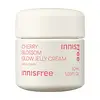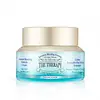What's inside
What's inside
 Key Ingredients
Key Ingredients

No key ingredients
 Benefits
Benefits

 Concerns
Concerns

 Ingredients Side-by-side
Ingredients Side-by-side

Water
Skin ConditioningGlycerin
HumectantPropanediol
SolventDipropylene Glycol
HumectantNiacinamide
SmoothingBetaine
Humectant1,2-Hexanediol
Skin ConditioningCarbomer
Emulsion StabilisingTromethamine
BufferingSodium Metaphosphate
BufferingAmmonium Acryloyldimethyltaurate/Beheneth-25 Methacrylate Crosspolymer
Emulsion StabilisingEthylhexylglycerin
Skin ConditioningParfum
MaskingPrunus Yedoensis Leaf Extract
Skin ConditioningTocopherol
AntioxidantWater
Skin ConditioningPropanediol
SolventBetaine
HumectantButylene Glycol
HumectantGlycerin
HumectantCyclopentasiloxane
EmollientCaprylic/Capric Triglyceride
MaskingDimethicone
Emollient1,2-Hexanediol
Skin ConditioningIsopropyl Isostearate
EmollientPropylene Glycol Dicaprylate/Dicaprate
EmollientCetearyl Olivate
Sea Water
HumectantHydrolyzed Algin
Persea Gratissima Oil
Skin ConditioningCymbopogon Martini Oil
MaskingSantalum Album Oil
MaskingHoney Extract
HumectantAvena Sativa Meal Extract
SoothingOcimum Sanctum Leaf Extract
Skin ConditioningOcimum Basilicum Oil
MaskingLavandula Angustifolia Flower Extract
CleansingRosa Damascena Flower Extract
MaskingSorbitan Olivate
EmulsifyingCyclohexasiloxane
EmollientHydrogenated Vegetable Oil
EmollientAmmonium Acryloyldimethyltaurate/Vp Copolymer
Trehalose
HumectantCaprylic/Capric Glycerides
EmollientGlyceryl Stearate
EmollientPEG-100 Stearate
Panthenol
Skin ConditioningBis-PEG-18 Methyl Ether Dimethyl Silane
EmollientPPG-26-Buteth-26
Skin ConditioningPEG-40 Hydrogenated Castor Oil
EmulsifyingButyrospermum Parkii Butter
Skin ConditioningHydrogenated Lecithin
EmulsifyingStearic Acid
CleansingDimethicone Crosspolymer
Emulsion StabilisingDimethiconol
EmollientEthylhexylglycerin
Skin ConditioningDisodium EDTA
Acrylates/C10-30 Alkyl Acrylate Crosspolymer
Emulsion StabilisingSodium Polyacrylate
AbsorbentAdenosine
Skin ConditioningXanthan Gum
EmulsifyingPotassium Hydroxide
BufferingMelia Azadirachta Leaf Extract
Skin ConditioningMelia Azadirachta Flower Extract
Skin ConditioningDiethylhexyl Syringylidenemalonate
Skin ProtectingCoccinia Indica Fruit Extract
Skin ConditioningAloe Barbadensis Flower Extract
EmollientSolanum Melongena Fruit Extract
Skin ConditioningCorallina Officinalis Extract
Skin ConditioningCurcuma Longa Root Extract
MaskingSucrose
HumectantPhenoxyethanol
PreservativeParfum
MaskingWater, Propanediol, Betaine, Butylene Glycol, Glycerin, Cyclopentasiloxane, Caprylic/Capric Triglyceride, Dimethicone, 1,2-Hexanediol, Isopropyl Isostearate, Propylene Glycol Dicaprylate/Dicaprate, Cetearyl Olivate, Sea Water, Hydrolyzed Algin, Persea Gratissima Oil, Cymbopogon Martini Oil, Santalum Album Oil, Honey Extract, Avena Sativa Meal Extract, Ocimum Sanctum Leaf Extract, Ocimum Basilicum Oil, Lavandula Angustifolia Flower Extract, Rosa Damascena Flower Extract, Sorbitan Olivate, Cyclohexasiloxane, Hydrogenated Vegetable Oil, Ammonium Acryloyldimethyltaurate/Vp Copolymer, Trehalose, Caprylic/Capric Glycerides, Glyceryl Stearate, PEG-100 Stearate, Panthenol, Bis-PEG-18 Methyl Ether Dimethyl Silane, PPG-26-Buteth-26, PEG-40 Hydrogenated Castor Oil, Butyrospermum Parkii Butter, Hydrogenated Lecithin, Stearic Acid, Dimethicone Crosspolymer, Dimethiconol, Ethylhexylglycerin, Disodium EDTA, Acrylates/C10-30 Alkyl Acrylate Crosspolymer, Sodium Polyacrylate, Adenosine, Xanthan Gum, Potassium Hydroxide, Melia Azadirachta Leaf Extract, Melia Azadirachta Flower Extract, Diethylhexyl Syringylidenemalonate, Coccinia Indica Fruit Extract, Aloe Barbadensis Flower Extract, Solanum Melongena Fruit Extract, Corallina Officinalis Extract, Curcuma Longa Root Extract, Sucrose, Phenoxyethanol, Parfum
Ingredients Explained
These ingredients are found in both products.
Ingredients higher up in an ingredient list are typically present in a larger amount.
1,2-Hexanediol is a synthetic liquid and another multi-functional powerhouse.
It is a:
- Humectant, drawing moisture into the skin
- Emollient, helping to soften skin
- Solvent, dispersing and stabilizing formulas
- Preservative booster, enhancing the antimicrobial activity of other preservatives
Betaine is a common humectant (a substance that promotes retention of moisture). It's known to be gentle on the skin and can help balance hydration.
This ingredient is best for improving hydration and soothing irritated skin. Studies also show it helps even out skin tone.
Fun fact: Betaine is naturally created in the skin and body. The kind found within cosmetic products can be either plant-derived or synthetic.
Another name for betaine is trimethylglycine.
Learn more about BetaineEthylhexylglycerin (we can't pronounce this either) is commonly used as a preservative and skin softener. It is derived from glyceryl.
You might see Ethylhexylglycerin often paired with other preservatives such as phenoxyethanol. Ethylhexylglycerin has been found to increase the effectiveness of these other preservatives.
Glycerin is already naturally found in your skin. It helps moisturize and protect your skin.
A study from 2016 found glycerin to be more effective as a humectant than AHAs and hyaluronic acid.
As a humectant, it helps the skin stay hydrated by pulling moisture to your skin. The low molecular weight of glycerin allows it to pull moisture into the deeper layers of your skin.
Hydrated skin improves your skin barrier; Your skin barrier helps protect against irritants and bacteria.
Glycerin has also been found to have antimicrobial and antiviral properties. Due to these properties, glycerin is often used in wound and burn treatments.
In cosmetics, glycerin is usually derived from plants such as soybean or palm. However, it can also be sourced from animals, such as tallow or animal fat.
This ingredient is organic, colorless, odorless, and non-toxic.
Glycerin is the name for this ingredient in American English. British English uses Glycerol/Glycerine.
Learn more about GlycerinParfum is a catch-all term for an ingredient or more that is used to give a scent to products.
Also called "fragrance", this ingredient can be a blend of hundreds of chemicals or plant oils. This means every product with "fragrance" or "parfum" in the ingredients list is a different mixture.
For instance, Habanolide is a proprietary trade name for a specific aroma chemical. When used as a fragrance ingredient in cosmetics, most aroma chemicals fall under the broad labeling category of “FRAGRANCE” or “PARFUM” according to EU and US regulations.
The term 'parfum' or 'fragrance' is not regulated in many countries. In many cases, it is up to the brand to define this term.
For instance, many brands choose to label themselves as "fragrance-free" because they are not using synthetic fragrances. However, their products may still contain ingredients such as essential oils that are considered a fragrance by INCI standards.
One example is Calendula flower extract. Calendula is an essential oil that still imparts a scent or 'fragrance'.
Depending on the blend, the ingredients in the mixture can cause allergies and sensitivities on the skin. Some ingredients that are known EU allergens include linalool and citronellol.
Parfum can also be used to mask or cover an unpleasant scent.
The bottom line is: not all fragrances/parfum/ingredients are created equally. If you are worried about fragrances, we recommend taking a closer look at an ingredient. And of course, we always recommend speaking with a professional.
Learn more about ParfumPropanediol is an all-star ingredient. It softens, hydrates, and smooths the skin.
It’s often used to:
Propanediol is not likely to cause sensitivity and considered safe to use. It is derived from corn or petroleum with a clear color and no scent.
Learn more about PropanediolWater. It's the most common cosmetic ingredient of all. You'll usually see it at the top of ingredient lists, meaning that it makes up the largest part of the product.
So why is it so popular? Water most often acts as a solvent - this means that it helps dissolve other ingredients into the formulation.
You'll also recognize water as that liquid we all need to stay alive. If you see this, drink a glass of water. Stay hydrated!
Learn more about Water